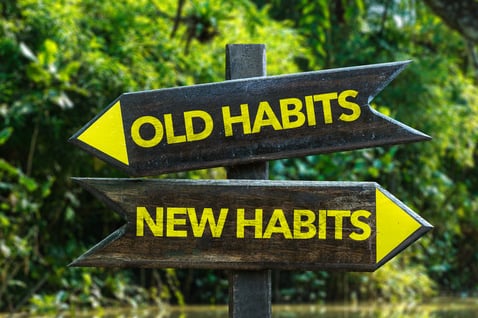Inbound Marketing Blog
for Manufacturers and Healthcare Companies
Identifying Good Habits of Top Sales & Marketing Performers
Are there any professions that have been changed by COVID-19 more than selling and marketing?
We’ve picked up some new habits -- some are good and some are … well, not so good.
It’s not easy building new habits -- at least the ones we want to build. Sales opportunities come and go, and the rapid pace makes it hard to executive meaningful changes to approach. But, it’s important to build new good habits, strengthen good old habits, and purge bad habits.
Read on if you need help identifying good habits of top sales and marketing performers.
For Top Sales & Marketing Performers, Excellence Is a Habit
Philosopher Will Durant once wrote, “We are what we repeatedly do. Excellence, then, is not an act, but a habit.”
If we want our sales and marketing efforts to succeed, we must build habits that breed excellence.
Keeping Good Sales & Marketing Habits
The way you nurture good habits may differ depending on the behavior you want to stick with you. However, you have to make good habits a priority if you want to keep them.
Take prospecting, for example. Many salespeople prioritized prospecting during the pandemic.

Maybe it was because they had more time -- remember, they weren’t traveling to trade shows. (And some still aren’t.)
Salespeople found themselves in front of a computer 24/7, so they focused on online B2B sales strategies and tactics. Prioritizing prospecting is a great habit to have picked up.
But now salespeople are returning to their offices and can travel a little more. It would be easy to go back and focus only on those traditional habits. The first step to prioritizing prospecting is self-awareness.
(Josh Curcio, COO and partner at p80, experienced this during the pandemic. Working from home, he found himself with time to spend in the HubSpot Community, which allowed him to not only help people with their inbound marketing problems but also score new leads. Being back in the office has made it harder for him to prioritize this activity, so he’s had to make a conscious effort.)
Your home environment may have been more relaxed and quiet, which helped you get more prospecting done. But now you’re back in the office -- a whole different atmosphere. It’s important to still prioritize your good prospecting habits.
Perhaps this means setting a block of time on your calendar where you focus only on prospecting. Maybe your office is noisy. Close your office door and put a sign on it that says, “Sales calls in progress.”
Don’t be afraid of goal accountability. Tell your boss or supervisor that you want to prioritize a set of habits and that you’d like to be held accountable for these habits. This way, they can help you stay on track and not let good habits drop.
(Josh presented on this topic at HubSpot’s 2021 Inbound Conference.)
Tools, Technology, & Resources to Keep Your Good Sales & Marketing Habits
Customer relationship management (CRM) tools are also great for accountability. You’re accountable for logging your activity. The activity is reported, measured, and viewed by others, making your actions (or inaction) transparent.
Log the fact that you had a phone call, that you had a meeting, that you touched base with a client, and then build reports and dashboards in your CRM. This way, you can have your activity ready to present in your sales meetings, even if the data shows you got a lot of “Nos” from leads.
(Salespeople may hate hearing “No,” but it’s part of the job and builds up your skills to help you get to that “Yes!”)
Track Lead Behavior
Tracking the behavior of the leads that come to your website is crucial. If you’re not doing it, do it. If you’re doing it, do it more. This allows you to make sure your strategies are working and enables you to pivot if they aren’t.
Say you had five contacts that turned into sales-qualified leads. What are they looking at? How are they behaving? How do we replicate that experience? How do we make content helpful to them?
Making this a daily habit may be overkill. A weekly review of the data allows you to build strong monthly and quarterly reports that can help evaluate your current strategy and map out the next quarter.
Prioritizing for the Small & Big Pictures
It may be easy for smaller habits to fall off your priority list. Let’s say today is the day you planned to track lead behavior for the week, but you’ve had to put out some “fires” at work, surprise client meetings have popped up, and you’re feeling under the weather. Something has to fall off the list.
However, consistently deprioritizing the small habits leads to big problems later on.
Remember, inbound marketing and sales are long games. Some of the more boring, humdrum tasks can sometimes get deprioritized because they don't bring immediate payoff. However, these tasks may be foundational to your success. Make sure you stay on top of them.
On the flip side, prioritize looking at the big picture regularly. Keep matching your monthly and quarterly reports to your annual goals. Which activities are driving you toward the goal, and how can you keep going in that direction? Where are you falling short, and how should you pivot? A regular review of the big picture will help you prioritize your activities in the small picture.
B2B Marketing & Sales Tips and Tricks That Cut Through the Noise

You may have noticed an uptick in B2B digital marketing tactics targeted toward you in the last year. Not all of these marketing tactics are good. You may have deleted the email, unsubscribed to a newsletter, or blocked an ad.
Which habits allow you to cut through the noise? Segmentation, personalization, and customization. The firehose approach of sending generic emails to everyone doesn’t help you close more deals. Segmenting your leads and customizing your B2B inbound marketing tactics based on their interests and pain points will yield better results. Be strategic and stand out from the crowd.
Marketer: ‘I Wish Sales Had These Habits’
Marketing and sales are both successful when they work together. On the sales side, it’s helpful if salespeople clearly label the buyer’s journey stage of each lead. Marketers need to know how a customer or a closed-lost lead came to a site so they know how to adjust content to better educate future leads for salespeople.
What did the customer find helpful? What content topics and styles (i.e. “how-to” blog posts vs. e-books) engaged them? Knowing this helps marketing to replicate successful user experiences.
Updating lead statuses in your CRM and making notes of any interesting engagements allows for marketing to see what’s going on. This communication allows for better collaboration between marketing and sales.
Marketing can also help sales by letting sellers know what existing assets are available and when new ones will be published.
Creating Good Habits, Avoiding Bad Habits
Scientific research has found over the years that going back into an old environment can trigger old habits.

For example, research shows that of all the people who enter addiction rehab, those who go back to their old environment -- both the location itself and the enablers inside it -- often relapse. Those who start hanging out with new people in a completely different context are not as likely to be drawn back into their addiction.
If you find something similar happening in your career, give yourself a little bit of grace. It’s completely normal. And, it’s largely an automatic, subconscious process that’s happening to you.
If you want to continue the good habits from when you were working at home, pay extra attention to your environment and how it changed. Maintaining some of those habits are going to be harder, and you're likely going to have to make a more conscious effort (i.e. blocking off calendar time or reorganizing your workspace).
Improving Our Automatic Responses
The difference between a habit and any other behavior is the habit is done on autopilot. It's an automatic response to a stimulus.
For example, have you ever been at the end of your commute and wondered, “How did I get here? I was daydreaming the whole time. I don't remember making any of the turns. I was on autopilot.”
That is our habit system at work. So much of our life is controlled by being on autopilot. This isn’t necessarily a bad thing. By improving our automatic behaviors, we end up more productive.
Engaging With Positive Emotions
Using rewards to create good habits can be tricky. The problem with this system is that there's too much of a time lag between getting the reward and doing the behavior. Many folks need that instant positive emotion after the behavior.
If you want to get better at making cold calls and pushing through those “No” responses, Step 1 is to reframe a “No.”
Salespeople know that they may hear, “No” 100 times before they hear, “Yes.” Look at a “No” as becoming one step closer to getting that “Yes.” In this way, you’ve reframed a “No” from a negative to a positive because it's gotten you closer to your goal.
BJ Fogg, a world-leading expert on habit formation, calls anything that makes you feel a positive emotion a “sense of shine.” So, when you get that “No,” you should do something immediately to get that sense of shine.
Some people like to recite an internal monologue where they say something positive to themselves. Try telling yourself, “Good job” in your head or aloud. Maybe you raise your arms in celebration. (We won’t judge you.)
The more you engage with that positive emotion, the quicker the habit will form.
Celebrate the Small Stuff
It’s hard to form a good habit if you attempt too much at once. For example, you may want to do pushups daily, but starting with 100 may prove impossible.

Celebrate the one pushup. Even if you do 100 pushups, celebrate each one. Continue to celebrate the small stuff, no matter how good you get.
Yeah, you got a “No” on that sales call. But you made the call, even though you didn’t want to or were super busy. Celebrate! You can celebrate even more when you get that “Yes.”
If you’re a marketer, celebrate that lead-capture form submission. We know that not every person who lands on the website is going to be a home run for our clients. At the same time, getting someone to the site to begin with can feel like nothing short of a small miracle for niche or B2B marketers.
Is It Time to Change Your Approach?
Forming good habits for sales and marketing takes effort and patience. Don’t expect to change everything in a day. Take one step at a time. Celebrate the small things. Don’t get discouraged.
If your old habits come back when you return to the office, find ways to change your environment so that those old habits don’t return. And, don’t be afraid to hold yourself accountable, or enlist someone to help you. We all have habits to improve -- even our superiors.
Are you looking to change up your sales and marketing strategies and learn new habits to achieve your goals? Sign up for a free inbound marketing/sales consultation below -- we’ll outline solutions that can improve marketing ROI and seller satisfaction.
Looking For a Deeper Dive?
For a deeper dive into the topic, watch the video version of this article above. Josh Curcio, COO and partner at protocol 80 (and self-proclaimed HubSpot expert), and Holly McCully, inbound marketing consultant at p80 (and niche inbound strategy expert), talk about how good sales and marketing habits are crucial to your success.
They talk with Gavin Brauer, CEO and founder at KindHuman Bicycles, who reveals the shared habits of top sales performers and marketers.
Our Blogs, Direct to Your Inbox!
How to Audit your Online Marketing
If you are executing digital marketing, congratulations! You are most likely already one step ahead of your competition, and making strides to meaningfully connect with prospects online. But, how do you know if you’re seeing continual success year over year, and improving your metrics?
Without the tools in place to analyze and benchmark your efforts, it is impossible to scale your online marketing and ensure continuous success.


